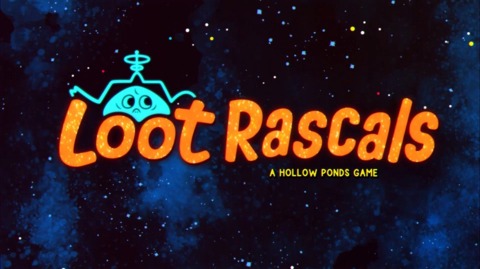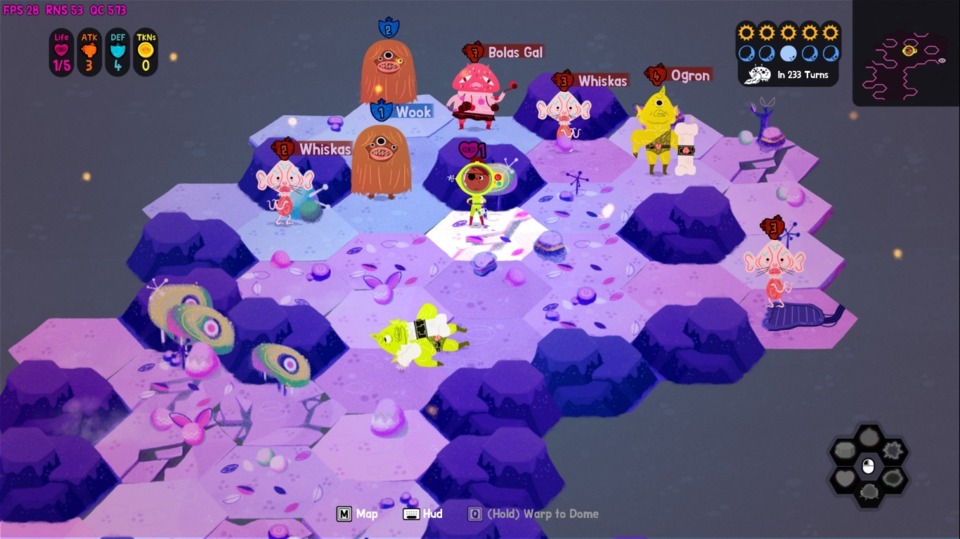Go! Go! GOTY! 2017: Game One: Loot Rascals
By Mento 0 Comments

- Game: Hollow Ponds's Loot Rascals.
- Release Month: March.
- Quick Look: N/A.
- Started: 01/12.
- Completed: N/A.
Our inaugural game for Go! Go! GOTY! this year is Loot Rascals, a quirky sci-fi roguelike from British developers Hollow Ponds. The game has what I would call a very contemporary animated TV show look, like The Marvelous Misadventures of Flapjack almost, with a vivid use of color to match. It actually took me a while to figure out what kind of game it was, but as soon as it introduced the turn-based movement and its randomized seed maps and drops it became evident quickly enough. This is a true dyed-in-the-wool roguelike in the traditional mold that includes everything except the ASCII graphics. Though you move on a hexagonal grid, the system is the same: enemies only move when you do, combat happens automatically whenever you and an enemy occupy the same space, you can find and equip various useful (though randomized) pieces of equipment, your only goal is to make it to the exit, and once you die you lose all progress and pick-ups and have to start anew.

One of the game's big differences is its rapid day/night cycle (it's on an alien moon, so I imagine they could fudge the passage of time a little) which determines how a particular enemy will attack: when fighting them during their "off" time, the player character attacks first. The idea, then, is to fall back until the day/night switch gives you the upper hand, striking when the enemy's vulnerable and ideally defeating them in one blow to avoid retaliation. There's also the game's atypical equipment system, which involves placing cards on a 2x5 grid in such a way to maximize their benefits. A card, either offensive (orange) or defensive (blue), will have a default strength value and any amount of additional modifiers: these modifiers might boost the strength of an adjacent card, or boost itself if the card is placed on the bottom row or an odd-numbered column, for example. As cards get stronger, they occasionally take on negative modifiers that the player must mitigate as much as they are able. It ends up being this little logic puzzle of putting the cards you have in the right slots to ensure as many positive modifiers (and as few negative modifiers) are active as possible. Any superfluous cards left in your deck can be broken down into "tokens": a currency that has a few uses, most notable of which is healing the player to full in the hub-area where the player begins and can later warp back to. I'm not even getting into the border effects, which changes an existing card and allows the player to use skills that slowly recharge over time which range from burning enemies at a distance to teleporting out of trouble, or certain unique cards that convey special passive conditions but lack any contribution to your offensive and defensive values, and thus the player has to carefully consider their benefits. Like with any good roguelike, a lot of variation is vital to ensuring that multiple runs bear significant enough changes to warrant this cyclical approach.
The game's aesthetic is definitely its strongest suit, but I had a few framerate issues as a result of how busy it could be. There's a few filter effects you can switch off, but even without them the game would regularly drop to 20 FPS the moment enough enemies appeared on-screen. I did like the designs of the various aliens you meet, many of which also have a selection of noises they make (one, called Bolus Girl, simply repeats "bolus" with different intonations), and a number of the tougher creatures have a few special abilities to watch out for - I almost died because I fought something that got a huge stat boost at the final moment, for reasons I'm still not sure about. The enemies can clearly buff each other, so occasionally it's a matter of kiting enemies away from the pack and dealing with them solo.
I have to say that the lack of any appreciable permanent progression - another staple of "true" roguelikes that I have little affection for - means that I'm only going to interested in playing Loot Rascals up to a point. Say what you will about the illusion of progression in games, where collecting all the doodads across an open-world map doesn't really amount to anything, but as someone who regularly aims for 100% completion it's always a little disheartening to lose all my progress in a heartbeat. You learn from your mistakes and get better, of course, and there's the rare occasion when you can recover one of the cards you lost if you find the enemy that killed you or were able to stash it away in time, but for the most part Loot Rascals is aiming for a slightly more modern, streamlined and almost board game-like take on the venerable RPG model that I can admire, if not wholeheartedly recommend. Right now, though, I've got other games to see.
